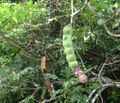Biology:Entada phaseoloides
| Entada phaseoloides | |
|---|---|

| |
| Entada phaseoloides pod specimen | |
| Scientific classification | |
| Kingdom: | Plantae |
| Clade: | Tracheophytes |
| Clade: | Angiosperms |
| Clade: | Eudicots |
| Clade: | Rosids |
| Order: | Fabales |
| Family: | Fabaceae |
| Subfamily: | Caesalpinioideae |
| Clade: | Mimosoid clade |
| Genus: | Entada |
| Species: | E. phaseoloides
|
| Binomial name | |
| Entada phaseoloides (L.) Merr.
| |
| Synonyms[1] | |
|
Acacia scandens (L.) Willd. | |
Entada phaseoloides[2][3][4][5][6] commonly named the box bean or St. Thomas' bean, first described by Linnaeus, with its current name described by Merrill. E. phaseoloides is a liana in the pea family:[7][8] called gugo, balugo, or tamayan in the Philippines and bàm bàm in Viet Nam. No subspecies are listed in the Catalogue of Life.[7]
Description
Entada phaseoloides is a large liana that climbs high into the lowland tropical forest canopy and is found in lowland coastal forests of Africa, Australia, Asia, and the Western Pacific. The lianas are often (but not exclusively) associated with waterways and seeds are widely dispersed by oceanic currents. Two subspecies have been described:[9]
- Entada phaseoloides subsp. phaseoloides
- Eentada phaseoloides subsp. tonkinensis
The leaf structure is a bi-pinnate compound divided into one to two pairs of leaflets. Leaflets are somewhat elliptical, between 25 and 100 mm (0.98 and 3.94 in) long and 10 to 60 mm (0.39 to 2.36 in) wide. Flowers are arranged in a raceme with green to red colored sepals and green / cream petals that are between 2–3.5 mm (0.079–0.138 in) long. The characteristic pods can grow very large, up to 2 m (6 ft 7 in) long and 130 mm (5.1 in) wide. Each pod contains between 10 and 20 reddish brown seeds that are lens-shaped and about 40 to 60 mm (1.6 to 2.4 in) in diameter.
Uses
Filipinos have been traditionally using gugo before commercial shampoos were sold in stores. The shampoo is obtained by soaking and rubbing the bark of the vine gugo (Entada phaseoloides),[10][11] producing a lather that cleanses the scalp effectively. Gugo is also used as an ingredient in hair tonics.[12] A study by the Department of Science and Technology found that gugo prevents hairfall because it stimulates micro circulation in the blood vessels.[13]
The people of Tonga use the beans of this plant (known as paʻanga) as ankle decorations for their traditional kailao dance as well as for use in an ancient game called lafo.[14][15] The paʻanga is also the name given to their currency.[15]
Gallery
References
- ↑ "Entada phaseoloides (L.) Merr. — the Plant List". http://www.theplantlist.org/tpl1.1/record/ild-39042.
- ↑ Verdcourt,B., 1979 A Manual of New Guinea Legumes. Office of Forests, Lae, PNG
- ↑ Ohwi,J., 1965 Flora of Japan. Washington: Smithsonian Institution
- ↑ Walker,E.H., 1976 Flora of Okinawa and S.Ryukyu islands. Washing.Smithson.Inst
- ↑ Wu,T.L., 1988 Mimososoideae. In: Fl.Reip.Pop.Sinicae, 39 (Leguminosae 1)
- ↑ Nielsen,I., 1981 Leg-Mim. In:Flore du Cambodge, du Laos et Viet-nam,Vol 19.A.
- ↑ 7.0 7.1 Roskov Y.; Kunze T. (2014). "Species 2000 & ITIS Catalogue of Life: 2014 Annual Checklist.". in Didžiulis V.. Species 2000: Reading, UK.. http://www.catalogueoflife.org/annual-checklist/2014/details/species/id/11482470. Retrieved 26 May 2014.
- ↑ ILDIS World Database of Legumes
- ↑ USDA National Plant Database (last edited 2001)
- ↑ Diaz, Eden C. (1990) (in en). Home Economics, Practical Arts and Livelihood Education for College: Book Two. Rex Bookstore, Inc.. p. 75. ISBN 978-971-23-0795-9. https://books.google.com/books?id=0D9zrQoLCuEC&pg=PA75. Retrieved 18 June 2021.
- ↑ Salas, Kinny (21 March 2014). "Thick, lush, sexy hair from drugstore products". Philippine Daily Inquirer. https://lifestyle.inquirer.net/154561/thick-lush-sexy-hair-from-drugstore-products/.
- ↑ Gonzales, Lucas L.; Quimio, Jr., Marcos J.; Calinawan, Rogelio. "Response of gugo to differing potting media". Canopy International (Department of Environment and Natural Resources) 27: 3. ISSN 0115-0960. http://erdb.denr.gov.ph/wp-content/uploads/2015/05/c_v27n4.pdf. Retrieved 18 June 2021.
- ↑ Enriquez, Marge C. (3 May 2011). "Is lauat the new, natural solution to falling hair?". Philippine Daily Inquirer. https://lifestyle.inquirer.net/457/is-lauat-the-new-natural-solution-to-falling-hair/.
- ↑ K, Lim T. (2012) (in en). Edible Medicinal And Non-Medicinal Plants: Volume 2, Fruits. Springer Science & Business Media. pp. 627–633. ISBN 978-94-007-1764-0. https://books.google.com/books?id=4MDEqFGeKVoC&dq=tonga+bean+entada&pg=PA632.
- ↑ 15.0 15.1 Spread, Patrick (2013) (in en). Support-bargaining, Economics, and Society: A Social Species. Routledge. pp. 200–201. ISBN 978-0-415-64112-8. https://books.google.com/books?id=G3fHTIP4S7IC&dq=tonga&pg=PA201.
External links
Wikidata ☰ Q3281753 entry
 |







